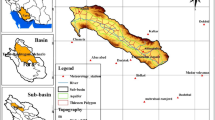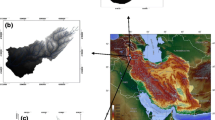Abstract
Groundwater level forecasting is a paramount necessity for integrated management of a basin. Development of suitable models is an essential step in determining groundwater level fluctuations in the future. The main objective of this study was to provide a powerful hybrid model by combining the group method of data handling (GMDH) and certain signal processing techniques, i.e., ensemble empirical mode decomposition (EEMD), wavelet transform (WT) and wavelet packet transform (WPT) for groundwater level forecasting in monthly time steps. Two different plains were selected to assess the performance of the afore-mentioned methods. The results showed that all of these preprocessing methods improved the capability of the group method of data handling model. The EEMD–GMDH model outperformed the WT–GMDH model. The WPT–GMDH model had a superior performance compared to both of the afore-mentioned hybrid models. However, it was shown that WPT–GMDH model had more computational cost that may affect the feasibility of this modeling approach in some cases. Finally, the EEMD–GMDH model can be introduced as a suitable modeling approach for groundwater level forecasting.














Similar content being viewed by others
References
Adamowski, J., & Sun, K. (2010). Development of a coupled wavelet transform and neural network method for flow forecasting of non-perennial rivers in semi-arid watersheds. Journal of Hydrology, 390(1–2), 85–91.
Aghajani, A., Kazemzadeh, R., & Ebrahimi, A. (2016). A novel hybrid approach for predicting wind farm power production based on wavelet transform, hybrid neural networks and imperialist competitive algorithm. Energy Conversion and Management, 121, 232–240.
Alvisi, S., & Franchini, M. (2011). Fuzzy neural networks for water level and discharge forecasting with uncertainty. Environmental Modelling and Software, 26(4), 523–537.
Banadkooki, F. B., Ehteram, M., Ahmed, A. N., Teo, F. Y., Fai, Ch M, Afan, H. A., et al. (2020). Enhancement of groundwater-level prediction using an integrated machine learning model optimized by whale algorithm. Natural Resources Research, 29, 3233–3252.
Bayat, P., Monjezi, M., Rezakhah, M., & Armaghani, D. J. (2020). Artificial neural network and firefly algorithm for estimation and minimization of ground vibration induced by blasting in a mine. Natural Resources Research, 29, 4121–4132.
Berkhahn, S., Fuchs, L., & Neuweiler, I. (2019). An ensemble neural network model for real-time prediction of urban floods. Journal of Hydrology, 575, 743–754.
Bui, Q. T., Nguyen, Q. H., Nguyen, X. L., Pham, V. D., Nguyen, H. D., & Pham, V. M. (2020). Verification of novel integrations of swarm intelligence algorithms into deep learning neural network for flood susceptibility mapping. Journal of Hydrology, 581, 124379.
Ciria, T. P., & Chiogna, G. (2020). Intra-catchment comparison and classification of long-term streamflow variability in the Alps using wavelet analysis. Journal of Hydrology, 587, 124927.
Ciria, T. P., Labat, D., & Chiogna, G. (2019). Detection and interpretation of recent and historical streamflow alterations caused by river damming and hydropower production in the Adige and Inn river basins using continuous, discrete and multiresolution wavelet analysis. Journal of Hydrology, 578, 124021.
Daliakopoulos, I. N., Coulibaly, P., & Tsanis, I. K. (2005). Groundwater level forecasting using artificial neural networks. Journal of Hydrology, 309, 229–240.
Daubechies, L. (1990). The wavelet transform, time-frequency localization and signal analysis. IEEE Transactions on Information Theory, 36, 961–1005.
Farfán, J. F., Palacios, K., Jacinto, U. J., & Avilés, A. (2020). A hybrid neural network-based technique to improve the flow forecasting of physical and data-driven models: Methodology and case studies in Andean watersheds. Journal of Hydrology, Regional Studies, 27, 100652.
Feng, Z., Liang, M., Zhang, Y., & Hou, S. (2012). Fault diagnosis for wind turbine planetary gearboxes via demodulation analysis based on ensemble empirical mode decomposition and energy separation. Renewable Energy, 47, 112–126.
Garcia, C., Zikos, G., & Tziritas, G. (2000). Wavelet packet analysis for face recognition. Image and Vision Computing, 18, 289–297.
Graf, R., Zhu, S., & Sivakumar, B. (2019). Forecasting river water temperature time series using a wavelet–neural network hybrid modelling approach. Journal of Hydrology, 578, 124115.
He, Z., Wen, X., Liu, H., & Du, J. (2014). A comparative study of artificial neural network, adaptive neuro fuzzy inference system and support vector machine for forecasting river flow in the semiarid mountain region. Journal of Hydrology, 509, 379–386.
Ivakhnenko, A. G. (1966). Group method of data handling—a rival of the method of stochastic approximation. Soviet Automatic Control, 1(3), 43–71.
Ivakhnenko, A. G. (1971). Polynomial theory of complex systems. IEEE Transactions on Systems, Man, and Cybernetics: Systems, 1(4), 364–378.
Kalantary, F., Ardalan, H., & Nariman-Zadeh, N. (2009). An investigation on the Su–NSPT correlation using GMDH type neural networks and genetic algorithms. Engineering Geology, 104, 144–155.
Kim, Y., Shin, H. S., & Plummer, J. D. (2014). A wavelet-based autoregressive fuzzy model for forecasting algal blooms. Environmental Modelling and Software, 62, 1–10.
Kisi, O. (2009). Neural networks and wavelet conjunction model for intermittent stream flow forecasting. Journal of Hydrologic Engineering, 14, 773–782.
Konikow, L. F., & Kendy, E. (2005). Groundwater depletion: a global problem. Hydrogeology Journal, 13(1), 317–320.
Li, X., Maier, H. R., & Zecchin, A. C. (2015). Improved PMI-based input variable selection approach for artificial neural network and other data driven environmental and water resource models. Environmental Modelling and Software, 65, 15–29.
Liu, H., Chen, C., Tian, H., & Li, Y. (2012). A hybrid model for wind speed prediction using empirical mode decomposition and artificial neural networks. Renewable Energy, 48, 545–556.
Mackay, J. D., Jackson, C. R., & Wang, L. (2014). A lumped conceptual model to simulate groundwater level time-series. Environmental Modelling and Software, 61, 229–245.
Mariyappa, N., Sengottuvel, S., & Parasakthi, C. (2014). Baseline drift removal and denoising of MCG data using EEMD: role of noise amplitude and the thresholding effect. Medical Engineering & Physics, 36(10), 1266–1276.
Mehdizadeh, S., Ahmadi, F., Danandeh Mehr, A., & Sadegh Safari, M. J. (2020). Drought modeling using classic time series and hybrid wavelet-gene expression programming models. Journal of Hydrology, 587, 125017.
Millie, D. F., Weckman, G. R., Young, W. A., Ivey, J. E., Carrick, H. J., & Fahnenstiel, G. L. (2012). Modeling microalgal abundance with artificial neural networks: Demonstration of a heuristic ‘Grey-Box’ to deconvolve and quantify environmental influences. Environmental Modelling and Software, 38, 27–39.
Moosavi, V., & Niazi, Y. (2015). Development of hybrid wavelet packet-statistical models (WP-SM) for landslide susceptibility mapping. Landslides, 13(1), 97–114.
Moosavi, V., Talebi, A., & Hadian, M. R. (2017). Development of a hybrid wavelet packet-group method of data handling (WPGMDH) model for runoff forecasting. Water Resources Management, 31, 43–59.
Moosavi, V., Talebi, A., Mokhtari, M. H., Fallah Shamsi, S. R., & Niazi, Y. (2015). A wavelet-artificial intelligence fusion approach (WAIFA) for blending landsat and MODIS surface temperature. Remote Sensing of Environment, 169, 243–254.
Moosavi, V., Talebi, A., Mokhtari, M. H., & Hadian, M. R. (2016). Estimation of spatially enhanced soil moisture combining remote sensing and artificial intelligence approaches. International Journal of Remote Sensing, 37(23), 5605–5631.
Moosavi, V., Vafakhah, M., Shirmohammadi, B., & Behnia, N. (2013). A wavelet-ANFIS hybrid model for groundwater level forecasting for different prediction periods. Water Resources Management, 27, 1301–1321.
Moosavi, V., Vafakhah, M., Shirmohammadi, B., & Ranjbar, B. (2014). Optimization of wavelet-ANFIS and wavelet-ANN hybrid models by taguchi method for groundwater level forecasting. Arabian Journal of Science and Engineering, 39, 1785–1796.
Najafzadeh, M. (2015). Neuro-fuzzy GMDH systems based evolutionary algorithms to predict scour pile groups in clear water conditions. Ocean Engineering, 99, 85–94.
Najafzadeh, M., Barani, G. A., & Hessami Kermani, M. R. (2013). GMDH based back propagation algorithm to predict abutment scour in cohesive soils. Ocean Engineering, 59, 100–106.
Najafzadeh, M., & Lim, S. Y. (2015). Application of improved neuro-fuzzy GMDH to predict scour depth at sluice gates. Earth Science Informatics, 8(1), 187–196.
Nourani, V., Alami, M. T., & Aminfar, M. H. (2009). A combined neural-wavelet model for prediction of Ligvanchai watershed precipitation. Engineering Applications of Artificial Intelligence, 22, 466–472.
Nourani, V., Kisi, Z., & Mehdi, K. (2011). Two hybrid artificial Intelligence approaches for modeling rainfall-runoff process. Journal of Hydrology, 402, 41–59.
Pal, S., & Devara, P. C. S. (2012). A wavelet-based spectral analysis of long-term time series of optical properties of aerosols obtained by lidar and radiometer measurements over an urban station in Western India. Journal of Atmospheric and Solar-Terrestrial Physics, 84–85, 75–87.
Rajaee, T. (2011). Wavelet and ANN combination model for prediction of daily suspended sediment load in rivers. Science of the Total Environment, 409, 2917–2928.
Ravisankar, P., & Ravi, V. (2010). Financial distress prediction in banks using group method of data handling neural network, counter propagation neural network and fuzzy ARTMAP. Knowledge-Based Systems, 23, 823–831.
Sameen, M. I., Pradhan, B., & Lee, S. (2019). Self-learning random forests model for mapping groundwater yield in data-scarce areas. Natural Resources Research, 28, 757–775.
Si, J., Feng, Q., Wen, X., Xi, H., Yu, T., Li, W., et al. (2015). Modeling soil water content in extreme arid area using an adaptive neuro-fuzzy inference system. Journal of Hydrology, 527, 679–687.
Takafuji, E. H., da Rocha, M. M., & Manzione, R. L. (2019). Groundwater level prediction/forecasting and assessment of uncertainty using SGS and ARIMA models: a case study in the Bauru Aquifer System (Brazil). Natural Resources Research, 28, 487–503.
Wang, N., Zhang, D., Chang, H., & Li, H. (2020a). Deep learning of subsurface flow via theory-guided neural network. Journal of Hydrology, 584, 124700.
Wang, H., Zhang, J., Zhang, L., Wang, J., & Xu, Z. (2020b). Gas emission and soil chemical properties associated with underground coal fires, Wuda Coalfield, Inner Mongolia, China. Natural Resources Research, 29, 3973–3985.
Wu, Z., & Huang, Z. (2009). Ensemble empirical mode decomposition: A noise-assisted data analysis method. Advances in Adaptive Data Analysis, 1, 1–41.
Yoon, H., Hyun, Y., Ha, K., Lee, K. K., & Kim, G. B. (2016). A method to improve the stability and accuracy of ANN- and SVM based time series models for long-term groundwater level predictions. Computers & Geosciences, 90, 144–155.
Yoon, H., Jun, S. C., Hyun, Y., Bae, G. O., & Lee, K. K. (2011). A comparative study of artificial neural networks and support vector machines for predicting groundwater levels in a coastal aquifer. Journal of Hydrology, 396, 128–138.
Yosefvand, F., & Shabanlou, S. (2020). Forecasting of groundwater level using ensemble hybrid wavelet–self-adaptive extreme learning machine-based models. Natural Resources Research, 29, 3215–3232.
Yu, Y., Li, W., Sheng, D., & Chen, J. (2015). A novel sensor fault diagnosis method based on modified ensemble empirical mode decomposition and probabilistic neural network. Measurement, 68, 328–336.
Yu, Zh, Yang, K., Luo, Y., & Shang, Ch. (2020). Spatial-temporal process simulation and prediction of chlorophyll-a concentration in Dianchi Lake based on wavelet analysis and long-short term memory network. Journal of Hydrology, 582, 124488.
Zhan, X. (2005). Parallel Fortran-MPI software for numerical inversion of the Laplace transform and its application to oscillatory water levels in groundwater environments. Environmental Modelling and Software, 20(3), 279–284.
Author information
Authors and Affiliations
Corresponding author
Rights and permissions
About this article
Cite this article
Moosavi, V., Mahjoobi, J. & Hayatzadeh, M. Combining Group Method of Data Handling with Signal Processing Approaches to Improve Accuracy of Groundwater Level Modeling. Nat Resour Res 30, 1735–1754 (2021). https://doi.org/10.1007/s11053-020-09799-w
Received:
Accepted:
Published:
Issue Date:
DOI: https://doi.org/10.1007/s11053-020-09799-w




